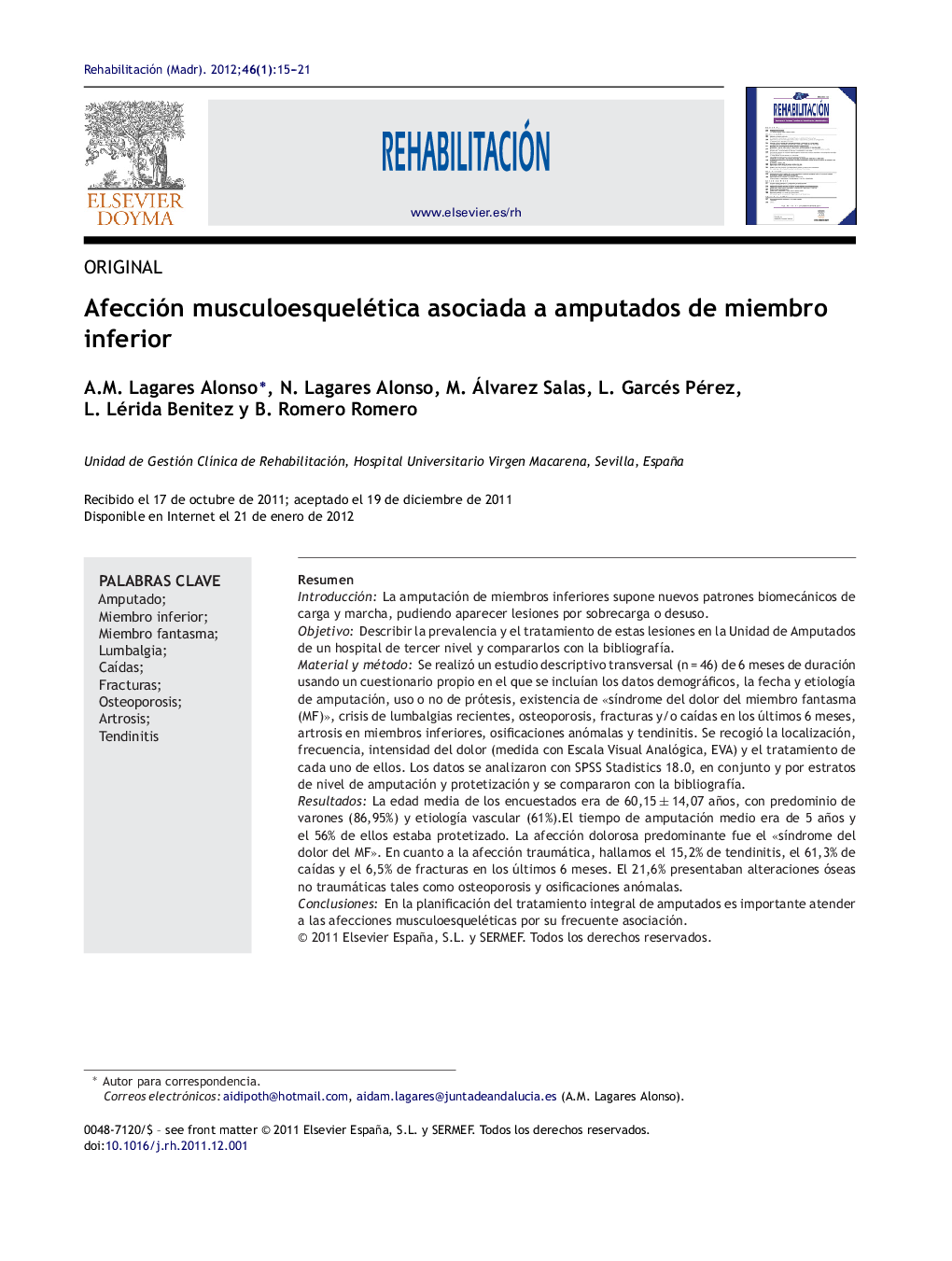| کد مقاله | کد نشریه | سال انتشار | مقاله انگلیسی | نسخه تمام متن |
|---|---|---|---|---|
| 4085054 | 1267825 | 2012 | 7 صفحه PDF | دانلود رایگان |

ResumenIntroducciónLa amputación de miembros inferiores supone nuevos patrones biomecánicos de carga y marcha, pudiendo aparecer lesiones por sobrecarga o desuso.ObjetivoDescribir la prevalencia y el tratamiento de estas lesiones en la Unidad de Amputados de un hospital de tercer nivel y compararlos con la bibliografía.Material y métodoSe realizó un estudio descriptivo transversal (n = 46) de 6 meses de duración usando un cuestionario propio en el que se incluían los datos demográficos, la fecha y etiología de amputación, uso o no de prótesis, existencia de «síndrome del dolor del miembro fantasma (MF)», crisis de lumbalgias recientes, osteoporosis, fracturas y/o caídas en los últimos 6 meses, artrosis en miembros inferiores, osificaciones anómalas y tendinitis. Se recogió la localización, frecuencia, intensidad del dolor (medida con Escala Visual Analógica, EVA) y el tratamiento de cada uno de ellos. Los datos se analizaron con SPSS Stadistics 18.0, en conjunto y por estratos de nivel de amputación y protetización y se compararon con la bibliografía.ResultadosLa edad media de los encuestados era de 60,15 ± 14,07 años, con predominio de varones (86,95%) y etiología vascular (61%).El tiempo de amputación medio era de 5 años y el 56% de ellos estaba protetizado. La afección dolorosa predominante fue el «síndrome del dolor del MF». En cuanto a la afección traumática, hallamos el 15,2% de tendinitis, el 61,3% de caídas y el 6,5% de fracturas en los últimos 6 meses. El 21,6% presentaban alteraciones óseas no traumáticas tales como osteoporosis y osificaciones anómalas.ConclusionesEn la planificación del tratamiento integral de amputados es importante atender a las afecciones musculoesqueléticas por su frecuente asociación.
IntroductionLower limbs amputations and the use of prostheses require new biomechanical walk patterns that can produce injuries.AimTo describe the prevalence and treatment of these diseases in lower limb amputees in the “Amputees unit” of a tertiary hospital and to compare these with the literature.Material and methodsA cross-sectional, descriptive study of 6 months duration was conducted on 46 subjects. A self-administered questionnaire was used, which included, demography data, the date and aetiology of amputation, the use or not of a prosthesis, “Phantom Pain Syndrome”, low back pain, osteoporosis, fractures or falls in the last 6 months, osteoarthritis, poor ossifications, and tendon inflammation. We also collected the location, frequency, intensity (EVA) and treatment of all of them. The data were analysed using the program SPSS Statistics 18.0 and then compared with that in the literature.ResultsThe mean age was 60 ± 14.07 years. The predominant sex was male (86.95%), and the most frequent aetiology was vascular limb damage (61%). The mean time since amputation was 5 years, and 56% of the patients used a prosthesis. The most frequent source of pain was “phantom”. Traumatic pathology: 15.2% of tendon injuries, 61.3% of falls in the last 6months, and 6.5% of bone fractures. Non-traumatic pathologies: 21.6%.ConclusionIn order to offer an integral treatment to amputees it is important to know these pathologies because of the frequent association.
Journal: Rehabilitación - Volume 46, Issue 1, January–March 2012, Pages 15–21